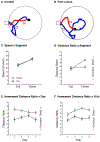Bilateral postsubiculum lesions impair visual and nonvisual homing performance in rats
- PMID: 31169384
- PMCID: PMC6721993
- DOI: 10.1037/bne0000321
Bilateral postsubiculum lesions impair visual and nonvisual homing performance in rats
Abstract
Nearly all species rely on visual and nonvisual cues to guide navigation, and which ones they use depend on the environment and task demands. The postsubiculum (PoS) is a crucial brain region for the use of visual cues, but its role in the use of self-movement cues is less clear. We therefore evaluated rats' navigational performance on a food-carrying task in light and in darkness in rats that had bilateral neurotoxic lesions of the PoS. Animals were trained postoperatively to exit a refuge and search for a food pellet, and carry it back to the refuge for consumption. In both light and darkness, control and PoS-lesioned rats made circuitous outward journeys as they searched for food. However, only control rats were able to accurately use visual or self-movement cues to make relatively direct returns to the home refuge. These results suggest the PoS's role in navigation is not limited to the use of visual cues, but also includes the use of self-movement cues. (PsycINFO Database Record (c) 2019 APA, all rights reserved).
Figures






References
-
- Alyan S, & McNaughton BL (1999). Hippocampectomized rats are capable of homing by path integration. Behav Neurosci, 113, 19–31. - PubMed
-
- Blair HT, Cho J, & Sharp PE (1998). Role of the lateral mammillary nucleus in the rat head direction circuit: a combined single unit recording and lesion study. Neuron, 21, 1387–1397. - PubMed

